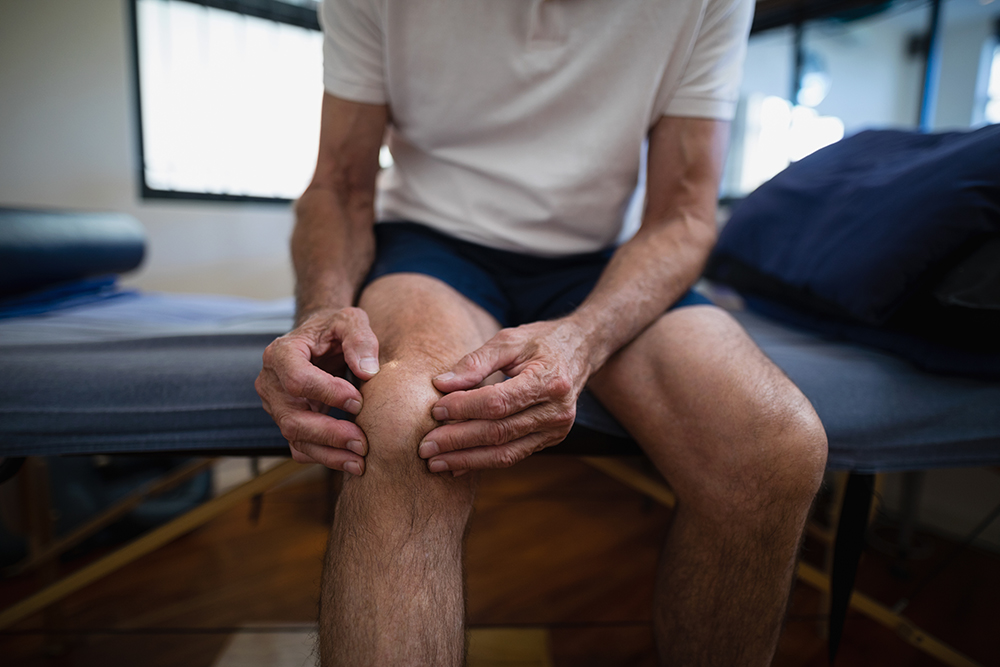Contents
What causes sharp pain in kneecaps?
Sudden, stabbing pain in kneecaps can disrupt daily life — and leave you wondering what’s going on beneath the surface. Frequent knee pain affects about 1 in 4 adults, and the kneecap (patella) is one of the most commonly affected areas. If you’re feeling sharp discomfort while walking, squatting, or even resting, it could point to an underlying issue. Physical therapy can help determine the cause and offer targeted treatment to relieve your symptoms.
Here are five of the most common reasons for feeling sudden sharp pain in knees:
1. Runner’s Knee (patellofemoral pain syndrome)
This overuse injury is one of the leading causes of kneecap pain, especially for people who run, squat, or jump often. The cartilage under the kneecap becomes irritated, leading to dull or sharp pain that worsens with movement. While it’s commonly called “runner’s knee,” anyone can develop it, not just runners. Treatment may include activity modification, knee bracing, and physical therapy focused on strengthening and correcting alignment.
2. Knee Bursitis
Bursae are small, fluid-filled sacs that reduce friction in joints. Inflammation in the bursa beneath the kneecap can cause sharp pain, swelling, redness, and warmth. You might feel a distinct tenderness or see visible puffiness in the front of the knee. Knee bursitis can result from kneeling for long periods, repetitive motions, or direct trauma. Physical therapy may involve stretches to relieve pressure on the bursa and improve joint function.
3. Jumper’s Knee (patellar tendinitis)
This condition affects the tendon that connects the kneecap to the shin. It’s common in sports involving frequent jumping — think basketball or volleyball — and can also develop from general overuse. Pain typically intensifies when climbing stairs, squatting, or landing from a jump. A physical therapist can help manage this pain with progressive loading exercises, flexibility training, and soft tissue work to reduce strain on the tendon.
4. Kneecap Dislocation/Subluxation
A dislocated or partially dislocated kneecap can cause immediate and intense pain. Your kneecap may feel unstable or visibly out of place. While some dislocations resolve on their own, others need medical attention. Even after the acute injury heals, the area can remain weak or unstable. Physical therapy focuses on restoring alignment and building strength around the joint to prevent future instability.
5. Patellar Fracture
A kneecap fracture is usually the result of a direct impact, like a fall or collision. It can cause severe, sharp pain, swelling, and difficulty moving the leg. Surgery is sometimes required, especially for displaced fractures. Whether or not surgery is necessary, pre- and post-operative physical therapy can help reduce stiffness, improve strength, and promote healing.
Physical Therapy Can Help Relieve Sharp Pain in Kneecaps
No matter the cause, sharp kneecap pain doesn’t have to become a long-term issue. Physical therapy offers a variety of evidence-based strategies for pain relief and recovery:
- Targeted strengthening — Weak thigh and calf muscles can contribute to poor kneecap alignment. Your PT will guide you through exercises like leg presses, step-ups, or resistance band routines to stabilize the knee.
- Aquatic therapy — Water-based exercises offer joint support while reducing impact. This is a great option if traditional weight-bearing exercises are too painful.
- Manual therapy — Hands-on techniques like joint mobilization and soft tissue release can help reduce stiffness, improve flexibility, and ease pain during movement.
- Stretching and flexibility work — A flexible quadriceps and hamstring group can relieve pressure on the knee joint and support proper patellar tracking.
Find relief from kneecap pain when walking in Rochester at Lattimore Physical Therapy
At Lattimore Physical Therapy, our licensed therapists specialize in helping patients recover from all kinds of knee injuries and conditions. We’ll work with you to identify the source of your kneecap pain and create a plan that helps you get moving again, with less pain and more confidence.
Schedule an appointment today to take the first step toward lasting knee relief.



